On this page
Books about FinchesThis page lists books about finches in Britain and around the world. The books are listed in order of publication date with the most recent at the top. True finches (family Fringillidae) are mainly seed eating birds found in the Northern Hemisphere - though there are exceptions. A number of other groups of birds are called finches even though not necessarily closely related to the Fringillidae. Books about all these finches are included on this page. Books about finches in captivity are not included.
Books about the Darwin's Finches of the Galapagos are listed on a separate page:books about Darwin's Finches.
Finches in the UK
Chaffinch
Fringilla coelebs
Brambling
Fringilla montifringilla
European Serin
Serinus serinus
European Greenfinch
Carduelis chloris
European Goldfinch
Carduelis cardeulis
Eurasian Siskin
Carduelis chloris
Common Linnet
Carduelis cannabina
Twite
Carduelis flavirostris
Common Redpoll
Carduelis flammea
Common Crossbill
Loxia curvirostra
Scottish Crossbill
Loxia scotica
Parrot Crossbill
Loxia pytyopsittacus
Scarlet (Common) Rosefinch
Carpodacus erythrinus
Common Bullfinch
Pyrrhula pyrrhula
Hawfinch
Coccothraustes coccothraustes
|
|
|
|
Grassfinches in AustraliaJoseph M Forshaw and Mark Shephard
CSIRO
2012
"After a lapse of almost half a century since publication of Klaus Immelmann's eminent work on finches, based on extensive field studies, the time has come for a new examination of Australian grassfinches. In Grassfinches in Australia, Joseph Forshaw, Mark Shephard and Anthony Pridham have summarised our present knowledge of each species, and have given readers a visual appreciation of the birds in their natural habitats and in aviculture. The resulting combination of superb artwork and scientifically accurate text ensures that this volume will become the standard reference work on Australian grassfinches. In addition to enabling aviculturists to know more about these finches in the wild as a guide to their own husbandry techniques, detailed information on current management practices for all species in captivity is provided. The book also includes colour plates depicting some of the more common mutations held in Australian and overseas collections."
|
Buy from amazon.co.uk 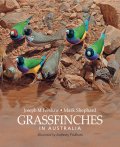
|
|
Finches & SparrowsPeter Clement
Illustrations: Alan Harris & John Davis
Christopher Helm
2011
This is a reprint of the 1993 publication
"This is a guide to true" finches and sparrows illustrating all the species, many races and most sex and age variations, with almost 950 portraits. The maps accompanying the illustrations show breeding and wintering ranges for all species."
|
Buy from amazon.co.uk 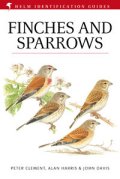
|
|
Tanagers, Cardinals, and Finches of the United States and Canada: The Photographic GuideDavid Beadle and J.D. Rising
Princeton University Press
2006
"This is the first comprehensive photographic identification guide to tanagers, cardinals, and finches. Many of North America's finest bird and wildlife photographers have supplied a stunning collection of images, some of which depict plumages rarely available in other publications. The 200 photographs have been carefully selected to illustrate age, seasonal, and sexual variation in all of the species found north of Mexico, including introduced species and vagrants. The text is designed to introduce the reader to the biology, identification, molts, vocalization, and distribution of the forty-six species covered. Each photograph is accompanied by a caption outlining relevant identification features, and original range maps illustrate the distributions of all the species that regularly occur north of Mexico."
|
Buy from amazon.co.uk
Buy from amazon.com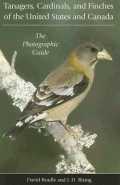
|
|
Sparrows and Finches of the Great Lakes Region and Eastern North AmericaChris G. Earley
Firefly Books
2003
"The Great Lakes region and Eastern North America is home to 48 species of sparrows and finches. This guide illustrates the subtle differences and rich diversity among these tiny birds. With crisp, clear photographs and precise identification notes, this book makes quick, accurate classification possible. The information is concisely organised and includes common and biological nomenclature, male/female differences, seasonal plumage changes and distinctive markings, song descriptions and behavioural habits."
|
Buy from amazon.co.uk 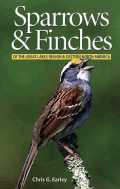
|
|
A Red Bird in a Brown Bag: The Function and Evolution of Colorful Plumage in the House FinchGeoffrey E. Hill
Oxford University Press
2002
"This is an account of studies of the function and evolution of colorful plumage in the House Finch. It is also an engaging study on the evolution of sexual selection in birds and a lively portrait of the challenges and constraints of experimental design facing any field investigator working with animal behavior. Part I sets the stage for modern studies of the function of plumage coloration with a review of the nineteenth and beginning of the twentieth centuries. Part II focuses on the proximate control and present function of plumage coloration. Part III takes a more explicitly evolutionary approach to the study of plumage coloration using biogeography and phylogeny to test hypotheses for why specific forms of plumage color display have evolved. It concludes with an account of comparative studies that have been conducted in the House Finch and other cardueline finches and the insight these studies have provided on the evolution of carotenoid-based ornamental coloration."
|
Buy from amazon.co.uk 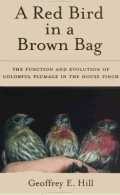
|
|
Sparrows & Finches of OntarioChris G. Earley
Point Pelee National Park Nature Series
Friends of Point Pelee / Lithosphere Press
2001
"An essential part of every birders kit, this book is printed on fine paper so that it can easily slip into a shirt pocket. Appendices include fold outs with side by side comparisons of birds by season. Written by Chris Earley with hundreds of photos by various photographers, including Jim Flynn."
|
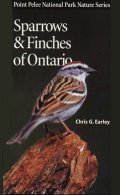 |
|
Finches & SparrowsPeter Clement
Illustrations: Alan Harris & John Davis
Christopher Helm
1999
This is a reprint of the 1993 publication
"This is a guide covers the 290 species of "true" finches and sparrows (the families Fringillidae, Carduelidae, Estrildidae and Passeridae). Full colour plates illustrate all the species, many races and most sex and age variations, with almost 950 portraits. Accompanying maps show breeding and wintering ranges. An introductory section gives an overview of the four families and the individual species text covers field identification, voice, geographical variation, habitat & range, migration, food, habits and description."
|
Buy from amazon.co.uk 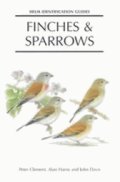
|
|
Finches & SparrowsPeter Clement
Illustrations: Alan Harris & John Davis
Princeton University Press
1999
"Among the most familiar and colorful of birds, finches and sparrows occupy almost every type of habitat throughout the world - from the environs of the Dead Sea to agricultural lowlands to the tops of the Himalayas. However, no comprehensive single-volume treatment of these families has appeared until now. Finches and Sparrows, which combines nearly 950 color portraits with detailed descriptions of every species, is an easy-to-use identification guide for birdwatchers, conservationists, and ornithologists, who, along with cagebird enthusiasts, will find this book an invaluable reference. For the first time all 290 species in the families Fringillidae, Estrildidae, and Passeridae are described and illustrated in color. The color plates feature every species, many races, and most sex and age variations, and the line drawings accompanying the text depict wing patterns, bill and head shapes, and other plumage details. Over 280 color maps show breeding and wintering ranges for all species. Sections on voice, status, behavior, distribution, movements, and measurements, together with information on species encountered in captivity, help make this the most comprehensive and up-to-date guide on these birds."
|
Buy from amazon.co.uk 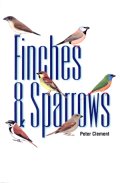
|
|
American GoldfinchAlex L.A. Middleton
Wild Bird Guides
Stackpole Books
1998
|
Buy from amazon.co.uk 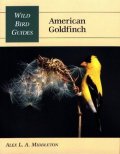
|
|
Finches, Bowerbirds and Other Passerines Of AustraliaEditor: Ronald Strahan
Birds Of Australia series
The National Photographic index of Australian Wildlife
Angus & Robertson
1996
"This volume includes: buntings; finches; sparrows; weavers; grass-finches; starlings and mynas; orioles and figbirds; drongos; bowerbirds; birds of paradise; magpie-larks; mud-nest builders; woodswallows; magpies, currawongs and butcherbirds; and crows and ravens. Full descriptions are given of each species, as well as breeding habits, habitat, food, voice, distribution and current status. Each entry is accompanied by colour photographs and distribution maps."
|
Buy from amazon.co.uk 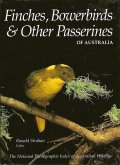
|
|
The Zebra Finch: A Synthesis of Field and Laboratory StudiesRobert A. Zann, Michael Bamford
Oxford University Press
1996
"The Australian Zebra Finch is widely used by researchers and teachers in many scientific disciplines where it is the preferred subject for investigations ranging from anatomy and physiology to behavioural development and evolutionary ecology. This monograph is the first to synthesize the information on this colourful species that has accumulated during the past thirty years. It summarizes and integrates much of the laboratory work and places it in the context of the biology of the animals in the wild, with an emphasis on behaviour and ecology. This leads to a detailed understanding of Zebra Finch adaptations and life history that will further enhance the value of the species for researchers and students in behaviour, ecology, and other fields." Contents: Systematics and phylogeny; Distribution and habitat; Morphology, domestication, and moult; Feeding ecology; Drinking, water relations, and temperature regulation; Coloniality and breeding ecology; Breeding periodicity; Populations; Social and reproductive behaviour; Vocalizations; Song; Sexual selection and mate choice; Life history and adaptations.
|
Buy from amazon.co.uk 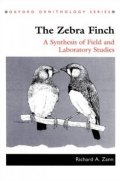
|
|
Finches & SparrowsPeter Clement
Illustrations: Alan Harris & John Davis
Christopher Helm
1993
"This is an identification guide to all world species of the true finches and sparrows. It describes the plumages and most distinctive races of all 290 species in the Fringillidae, Carduelidae, Estrildidae and Passeridae families. Each species has a colour map showing its distribution."
|
Buy from amazon.co.uk 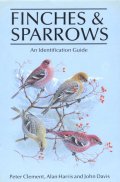
|
|
Estrildid Finches of the WorldD. Goodwin
Oxford University Press / Cornell University Press
1982
"In this, the third in his series on the bird groups, David Goodwin describes the estrildids, a colourful group that have long been popular as aviary birds. He deals with behaviour, biology, coloration, adaptive radiation and other aspects, describing each species in detail, and also gives information on keeping the birds. The book includes maps and diagrams, as well as colour plates by Martin Woodcock."
|
Buy from amazon.co.uk 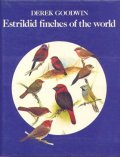
|
|
Pine Crossbills: A Scottish ContributionDesmond Nethersole-Thompson
Illustrations: Donald Watson
Poyser
1975
"From this study and a quest for the true identity of the Speyside crossbills has emerged that all too rare book, a work of scholarship and research that is wholly readable, in which the author`s delight in his study subject becomes the reader`s too."
|
Buy from amazon.co.uk 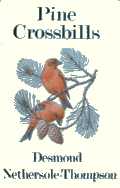
|
|
FinchesIan Newton
Collins
New Naturalist 55
1972
"This illustrated survey of finch behaviour is a thorough, non-technical account of the habits of these birds throughout the world. Dr. Newton uses his extensive bird-watching experience and knowledge of the published literature to document the main patterns of feeding, development of feathers, breeding, and migration. As a result, he presents the changing relationship of the birds to their environment."
|
Buy from amazon.co.uk 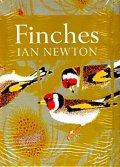
|
|
Australian FinchesKlaus Immelmann
Paintings: Neville Cayley
Angus & Robertson
1965
Reprinted with different covers
A study of the Estrildid Finches of Australia.
|
Buy from amazon.co.uk 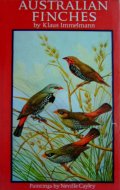
1972 edition
|
|
Bird Study, Volume 6, Issue 31959
Main articles:
- The Post-Fledging Mortality of the Kittiwake - J. C. Coulson & E. White
- The Origin of Winter Visitors to the British Isles 2. Chaffinch (Fringilla coelebs) - M. J. Goodacre
- The Origin of Winter Visitors to the British Isles 3. Brambling (Fringilla montifringilla) - M. J. Goodacre
- Some Factors Influencing Sexual and Aggressive Behaviour in Male Chaffinches - R. A. Hinde
- A Winter Census on the Wash - D. K. Ballance & G. L. Scott
- Fleas from Nests of the Pied Flycatcher and other Species in the Forest of Dean - R. S. George
- The Birds of High-Level Woodlands the Winter Population - W. B. Yapp
|
|
|
The HawfinchGuy Mountford
Collins
The New Naturalist Monograph 15
1957
A 176 page study of the Hawfinch.
|
Buy from amazon.co.uk 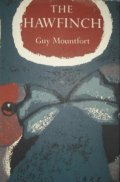
|
|
Behaviour of the Chaffinch Fringilla Coelebs P. Marler
Behaviour, Supplement No. 5
E. J. Brill
1956
From the abstract: "This study of Chaff inch behaviour was carried out in the neighbourhood of Madingley near Cambridge, on wild and aviary birds. All the main movements and calls are described. The movements are divided broadly into 'functional acts' and 'displays', which are broken down into components."
|
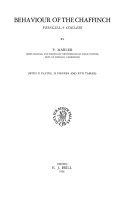 |
|
A Systematic Study Of The Avian Family Fringillidae Based On The Structure Of The SkullHarrison B. Tordoff
Museum Of Zoology, Miscellaneous Publications No. 81
University of Michigan
1954
From the preface: "In spite of the relatively advanced state of avian taxonomy, relationships of certain groups, especially in the large order of perching birds, the Passeriformes, remain little understood today. Life-history studies have given important clues in many problems; other problems seem most apt to yield to morphological studies. This paper is a report on a study in the latter category."
|
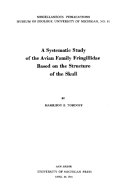 |
|
Bird Study, Volume 1, Issue 11954
Contents.
- Foreword - Major-General H. P. W. Hutson
- The Breeding Biology of the Greenfinch - J. F. Monk
- Two Robin Populations - David Lack
- Back Garden Ornithology - Rev. P. H. T. Hartley
|
|
|
The Birds Of North And Middle America: A Descriptive Catalogue
Part I: Family Fringillidae - The Finches
Robert Ridgway
Bulletin No. 50
Smithsonian Institution
United States National Museum
1900
From the preface: "Although preparations for the present work have been more or less actively conducted for some twenty years past, as time and opportunity permitted, the actual work of putting together the vast amount of material accumulated during that period was not begun until September, 1894, when the author was directed by Dr. G. Brown Goode, Assistant Secretary of the Smithsonian Institution, in charge of the National Museum, to consider of paramount importance among his official duties the task of 'making available, through publication, the results of the ornithological work of the Government, as represented in the collections of the Smithsonian Institution.' The labor of collating references pertaining to more than 3,000 species of birds, verifying citations of original descriptions, measuring many thousands of specimens, and other time-consuming details connected with the preparation of such a work has necessarily delayed the beginning of its publication; but most of this drudgery having been disposed of, it is hoped that future progress may be more rapid. In the following pages the attempt is made to describe every species and subspecies, or definable form, of bird found on the continent of North America, from the arctic districts to the eastern end of the. Isthmus of Panama, together with those of the West Indies and other islands of the Caribbean Sea (except Trinidad and Tobago), and the Galapagos Archipelago; introduced and naturalized species being included, as well as accidental or casual visitors. The classification presented is essentially that of the most recent and advanced authorities, with such minor modifications as in the judgment of the present author seem desirable. The imperfection of our knowledge concerning the internal structure of many groups of birds, however, makes an entirely satisfactory classification impossible at the present time, and that here adopted must therefore be considered as provisional only. An entirely sound classification of birds is a matter of the future, requiring vastly extended investigations in the field of avian anatomy and the expenditure of an enormous amount of time and labor in elaborating the results."
|
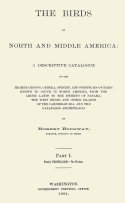
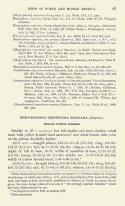
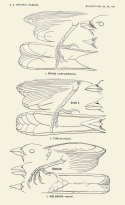 |
|
Handbook Of The Sparrows, Finches, etc., Of New England
C.J. Maynard
1896
From the introduction: "My reason for writing a book upon birds with such a limited scope as the present, is because 1 am sure, from a somewhat extended experience, that it is better for those beginning the study of ornithology to first become thoroughly acquainted w4th some one group of birds, than to acquire a smattering knowledge of many. I have therefore selected the largest and in some ways the most important family of our New England birds, partly, because it is the most extended, but more particularly, because there is no season of the year, when some members of it are not to be found with us. In my walks in the fields and woods with my many pupils, I have found that some experience great difficulty m learning to distinguish birds, either by sight or by hearing their songs. This difficulty, it appears to me, is really due to the fact that the observer is trying to grasp an entirely new, and too vast a subject without a sufficient training of eye and ear. This being undoubtedly the case with so many, it appears best to begin with a group of birds, most of which are of a sufficient size to be readily seen and which not only have prominent, characteristic markings, but which also have songs which are readily distinguishable."
|
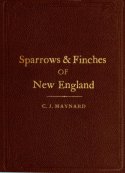
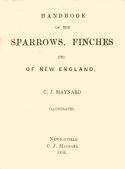

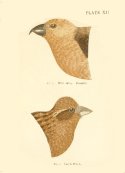 |
|
Catalogue Of The Passeriformes or Perching Birds In The Collection Of The British MuseumFringilliformes: Part III, containing the family Fringillidae
Catalogue Of The Birds In The British Museum, Volume XII
R. Bowdler Sharpe
16 colour plates: W. Hart, J.G. Keulemans
Printed By Order Of The Trustees
Printed by Taylor & Francis
1888
From the introduction: " The number of specimens of Fringillidae recorded in the present volume is 9443, exceeding by several thousands the contents of any previous volume of the 'Catalogue of Birds.' The number of species recorded is 559, of which only 30 are unrepresented in tbe Museum collection, which contains likewise the types of no less than 125 species. The line of demarcation between the families Fringillidae and Tanagridae seems to be an extremely arbitrary one, and many genera included by me as Finches are just as likely to be Tanagers, if there is really a definable character for the separation of the two families. I allude more especially to such forms as Piezorhina, Chamoeospiza, Coryphospingus, &c. Some distinctive characters may ultimately be discovered in the anatomy of the Fringillidae and Tanagridae which will serve to separate them; but at present the whole classification of these birds is highly unsatisfactory."
|
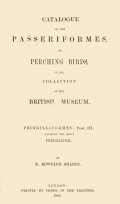
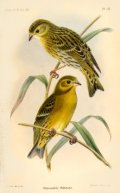
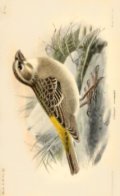 |
|
A Monograph Of The Weaver-Birds, Ploceidae, and Arboreal And Terrestrial Finches, Fringillidae
Edward Bartlett
Illustrations: F.W. Frohawk
Published by the author
1888
|
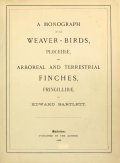
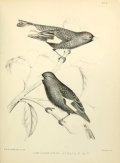
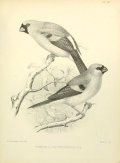 |
|
A Review Of The American Crossbills (Loxia) Of The L. Curvirostra Type
Robert Ridgway
Volume 2, pages 101-107
Proceedings of The Biological Society of Washington
1885
Opening lines: "Having long suspected the existence of two forms of the Red Crossbill in the United States, besides the Mexican race (Z. mexicana Strickl.) which occurs just within our borders in Southern Arizona (and perhaps also in New Mexico), I was not surprised to find this conviction fully confirmed by a fine series of specimens presented to the National Museum by Captain Chas. E. Bendire, U. S. A., and obtained by him at Fort Klamath, Oregon, during the winter of 1882-83. The form under consideration being unquestionably distinct from both L. americana and L. mexicana, as well as from the several Palearctic races, and being, so far as I am able to discover, unnamed, I take great pleasure in dedicating it to Captain Bendire as a slight recognition of his very valuable services to North American ornithology."
|
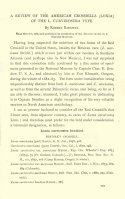 |
|
A Revision of the Species of the Fringilline Genus Sycalis
P.L. Sclater
2 colour plates (Sycalis chrysops and Sycalis lutea / Sycalis aureiventris): J.G. Keulemans
Volume 14, Issue 1, pages 39-48
Isis
1872
Opening lines: "In 'The Ibis' for January last, I attempted to give some account of the present state of our knowledge of the species of the Fringilline genus Spermophila. I now propose to offer to the readers of this Journal some similar remarks on the members of the genus Sycalis, another characteristic type of the Neotropical Fringillidse, of which I have of late years accumulated a considerable series of specimens. My collection of this genus consists of 40 skins, referable to 8 species. I have likewise employed for comparison 18 specimens belonging to the collection of. Messrs. Salvin and Godman, and referable to 6 species, and have examined the specimens in the French National Collection, where several important types are to be found."
|
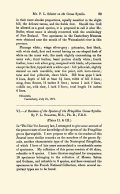
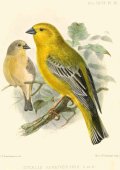 |
|
Description of a new Genus and Species of Bird belonging to the Family Fringillidae
D.G. Elliot
Colour plate (Dolospingus nuchalis): J.G. Keulemans
Volume 13, Issue 4, pages 402-403
Isis
1871
Opening lines: "The singular Finch here described was received by Madame Verdey, of Paris, in a small collection obtained on the Orinoco river, on the borders of British Guiana. In its general coloration and in the markings of its plumage it is not unlike the members of the genus Spermophila, and, were it not for its extraordinary bill, would seem to find its place most naturally in that genus. But the bill precludes such a disposition of this species; and indeed there is no genus known to me under which it may be classified; I have therefore proposed the term Dolospingus for this curious form. The type specimen was the only one sent, and now belongs to the Museum of Natural History of New York, for whose fine collection I have secured it."
|
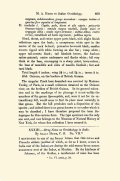
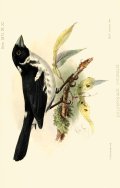 |
|
A Revision of the Species of the Fringilline Genus Spermophila
P.L. Sclater
2 colour plates (Spermophila nicrorufa and Spermophila pileata / Spermophila aurita and Spermophila ocellata): J.G. Keulemans
Volume 13, Issue 1, pages 1-23
Isis
1871
Opening lines: "Up to the present time the best, and, indeed, it may be said the only authority worth referring to on the American Finches of the genus Spermophila has been Bonaparte's 'Conspectus Generum Avium.' In that well-known work this and the allied genera of Fringillidae are treated of with unusual accuracy, and short but, in most cases, sufficient diagnoses are added to the synonyms of the different species. In my 'Catalogue of Arnerican Birds' I have relied mainly upon Bonaparte's arrangement of the genus Spermophila, merely altering the order to a certain extent, and including among the true Spermophilae the species which Bonaparte has placed in the second division of his genus Sporophila."
|
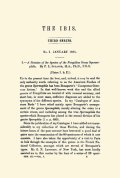
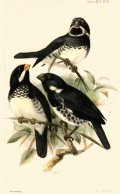 |
|